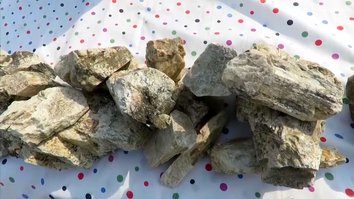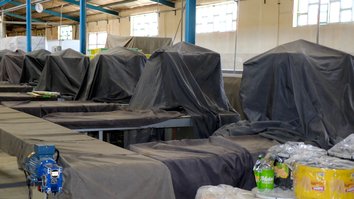MES AYNAK -- An ancient city carved out of immense peaks in Logar province near Kabul is in danger of disappearing forever, swallowed up by a Chinese consortium exploiting one of the world's largest copper deposits.
Located at the confluence of Hellenistic and Indian cultures, Mes Aynak -- believed to be between 1,000 and 2,000 years old -- was once a vast city organised around the extraction and trade of copper.
Archaeologists have uncovered Buddhist monasteries, stupas, fortresses, administrative buildings and dwellings, while hundreds of statues, frescoes, ceramics, coins and manuscripts also have been unearthed.
Mes Aynak is "one of the most beautiful archaeological sites" in the world, Bastien Varoutsikos, an archaeologist for the French company Iconem, which is working to digitise the city and its heritage, told AFP.
![Part of the archaeological site in Mes Aynak is seen here in a photograph taken May 17. The ancient Buddhist city carved out of immense peaks near Kabul is in danger of disappearing forever, swallowed up by a Chinese consortium exploiting one of the world's largest copper deposits. [Wakil Kohsar/AFP]](/cnmi_pf/images/2022/06/23/35936-afghan-ancient-city-585_329.jpg)
Part of the archaeological site in Mes Aynak is seen here in a photograph taken May 17. The ancient Buddhist city carved out of immense peaks near Kabul is in danger of disappearing forever, swallowed up by a Chinese consortium exploiting one of the world's largest copper deposits. [Wakil Kohsar/AFP]
![A Chinese copper mining project poses a direct threat to this ancient Buddhist city carved out of immense peaks near Kabul. The archaeological site in Mes Aynak is seen here on May 17. [Wakil Kohsar/AFP]](/cnmi_pf/images/2022/06/23/35937-afghan-city-hillside-585_329.jpg)
A Chinese copper mining project poses a direct threat to this ancient Buddhist city carved out of immense peaks near Kabul. The archaeological site in Mes Aynak is seen here on May 17. [Wakil Kohsar/AFP]
![Part of a statue of Buddha that was uncovered at an archaeological site in Mes Aynak, Logar province, is seen here on May 17. [Wakil Kohsar/AFP]](/cnmi_pf/images/2022/06/23/35938-buddha-statue-afghanistan-585_329.jpg)
Part of a statue of Buddha that was uncovered at an archaeological site in Mes Aynak, Logar province, is seen here on May 17. [Wakil Kohsar/AFP]
Objects discovered date mainly from the 2nd to 9th century CE, but pottery also has been found at the site that dates back to the Bronze Age.
Burying the past
Mes Aynak has been compared to Pompeii, Italy, and Machu Picchu, Peru, in size and significance, with ruins that cover 1,000 hectares perched high on a massive peak.
But China is in dire need of copper, and in 2007 the Chinese mining giant Metallurgical Group Corporation headed a state-owned consortium and signed a $3 billion contract to mine ore over 30 years. The consortium is now called MJAM.
Though insecurity and disagreements between Beijing and Kabul over financial terms of the contract caused delays, the project is once again a priority for both parties, and talks are ongoing on how to proceed.
Fears are rising that a place once considered one of the most prosperous trade hubs on the Silk Road could disappear without oversight.
In the early 2010s, it was "one of the largest archaeological projects in the world", Varoutsikos said.
MJAM originally suspended the start of operations for three years to allow archaeologists to focus on the area directly threatened by the mine.
That period was inadvertently lengthened as the security situation prevented the Chinese from building planned infrastructure.
As a result, thousands of objects were unearthed -- some were taken to the Kabul museum, others kept nearby. But many of the remains are simply too bulky or fragile to be moved, and seem destined to disappear.
The Chinese favour open-pit rather than underground mining. If it goes ahead, it would open up the copper mountain and bury all the fragments of the past.
Environmental consequences
The Chinese project has raised concerns about environmental consequences, as copper mining is polluting and requires large quantities of water, and as Logar is already an arid region.
But the prospect of money appears to be driving the mine project forward.
The Mes Aynak mine has the potential to generate more than $300 million a year -- about 60% of the full Afghan government budget for 2022 -- and plans are in motion to speed up the process.
The discussions are reportedly "80% finished" on the contract -- which includes the construction of a power station to supply the mine and Kabul, and a railway to Pakistan -- with only technical points remaining to be settled.
For now, the delay is some salvation for archaeologists.
While there is no work going on at the site, Varoutsikos hopes to restart the excavation before the start of mining operations.
But even that will depend on international collaboration and funding, he said.
Caution is needed
Afghanistan is sitting on huge mineral resources of copper, iron, bauxite, lithium and rare earth metals estimated to be worth more than $1 trillion.
China has eyed Afghanistan's rare earth metal deposits for years and has been waiting for the right opportunity to lay its hands on them as they provide a great source of profit, said Abdul Ghafoor Nawrozi, a civil society activist in Herat city, last December.
In a November visit to Herat province, one Chinese businessman stressed his interest in investing in the processing and selling of Afghan saffron.
Soon after, a number of Chinese investors arrived in Afghanistan to look into investing in the country's lithium deposits, China's Global Times reported.
Efforts by Chinese companies to invest in Afghanistan's mining sector since last August also have raised questions among Afghans.
Caution is needed when awarding contracts to Chinese mining companies to avoid the plundering of Afghanistan's natural resources, said economist Sayed Kabir Hussaini of Herat city, also in December.
"Chinese companies will never invest in Afghanistan unless they make a lot of profit in return," he said. "Agreements with these companies must be designed to prevent any loss to Afghanistan."
Rare earth metal and precious metal deposits should not be given to Chinese companies on the cheap, Hussaini added, noting that China's singular focus on those deposits does not indicate good intentions.

![The base of a Chinese consortium in Mes Aynak is seen here in a photo taken May 17. The copper mining project is threatening an ancient city carved out of immense peaks at the site. [Wakil Kohsar/AFP]](/cnmi_pf/images/2022/06/23/35935-china-consortium-afghanistan-585_329.jpg)






